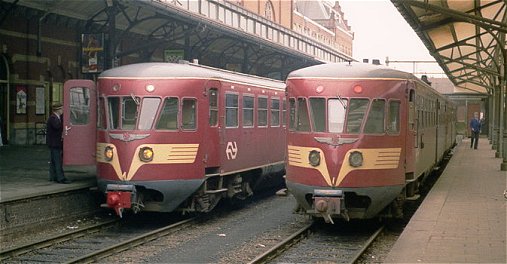Jernbane
|
Nederlandske Jernbaner |
|
|
|
Stemningsbillede fra Groningen - April 1979 - Kai W. Mosgaard © |
|
The Netherlands has an extensive and much-used railway network, which connects virtually all cities and many towns with each other. (Large towns without a train station are well aware of this status, e.g. Katwijk and Amstelveen.) Trains are frequent, with one or two trains per hour on lesser lines, two to four trains per hour on most lines in the country and up to 8 or 10 trains an hour between the big cities. Trains are divided into two categories: stoptreinen (local trains, which call at all stations; these are called Sprinters on some lines) and intercities, which provide fast connections between the bigger cities. A former intermediate category of sneltreinen (fast trains) was dissolved in 2007. The railways of the Netherlands are all standard gauge (1.435 m), and they sum up to a total of 2809 route-kilometers or 6505 track-kilometers. 2061 kilometers are electrified (2001) at 1500 volt DC. Only 931 km is single track. The country counts 3,004 level crossings, of which 2,144 are protected. ProRail takes care of maintenance and extensions of the national railway network infrastructure (but excluding metros and trams, for which see below), allocating rail capacity, and traffic control. The rail capacity supplied by ProRail is used by five public transport operators (see below) as well as cargo operators: Railion, ERS, ACTS, Rail4Chem. Aside from these, there are a few tiny operators, amongst whom for example Herik Rail, with seven carriages, where trains can be chartered for parties, meetings, etc. (kilde: Wikipedia) |
|
|
||
|
|
|
|
|
|
|
|


